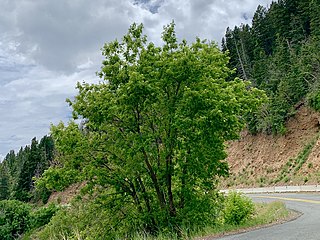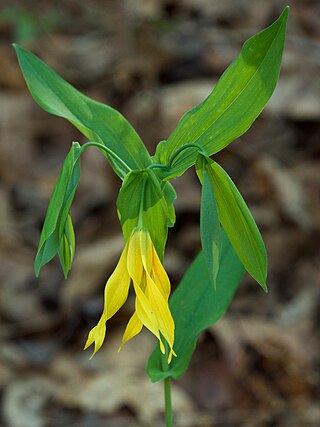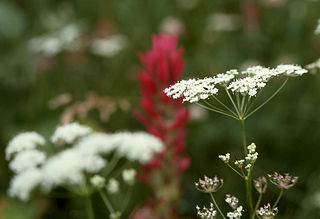
Acer negundo, the box elder, boxelder maple, Manitoba maple or ash-leaved maple, is a species of maple native to North America. It is a fast-growing, short-lived tree with opposite, compound leaves. It is sometimes considered a weedy or invasive species, and has been introduced to and naturalized throughout much of the world, including in South America, Australia, New Zealand, South Africa, much of Europe, and parts of Asia.

Ribes triste, known as the northern redcurrant, swamp redcurrant, or wild redcurrant, is an Asian and North American shrub in the gooseberry family. It is widespread across Canada and the northern United States, as well as in eastern Asia.

Sagittaria latifolia is a plant found in shallow wetlands and is sometimes known as broadleaf arrowhead, duck-potato, Indian potato, or wapato. This plant produces edible tubers that have traditionally been extensively used by Native Americans.

Vaccinium myrtilloides is a shrub with common names including common blueberry, velvetleaf huckleberry, velvetleaf blueberry, Canadian blueberry, and sourtop blueberry. It is common in much of North America, reported from all 10 Canadian provinces plus Nunavut and Northwest Territories, as well as from the northeastern and Great Lakes states in the United States. It is also known to occur in Montana and Washington.

Uvularia grandiflora, the large-flowered bellwort or merrybells, is a species of flowering plant in the family Colchicaceae, native to eastern and central North America.

Sagittaria montevidensis is a species of flowering plant in the water-plantain family Alismataceae. Common names include giant arrowhead and California arrowhead.

Sagittaria lancifolia, the bulltongue arrowhead, is a New World perennial, monocot plant in the family Alismataceae, genus Sagittaria, with herbaceous growth patterns.

Perideridia gairdneri is a species of flowering plant in the family Apiaceae known by the common names common yampah, Gardner's yampah and Squaw root. It is native to western North America from southwestern Canada to California to New Mexico, where it grows in many types of habitat. It is a perennial herb which grows to around .6–1 metre (2.0–3.3 ft). Its slender, erect stem grows from cylindrical tubers measuring up to 8 centimeters long. Leaves near the base of the plant have blades up to 35 centimeters long which are divided into many narrow, subdivided lobes. Leaves higher on the plant are smaller and less divided. The inflorescence is a compound umbel of many spherical clusters of small white flowers. These yield ribbed, rounded fruits each a few millimeters long.

Yucca glauca is a species of perennial evergreen plant, adapted to xeric (dry) growth conditions. It is also known as small soapweed, soapweed yucca, Spanish bayonet, and Great Plains yucca.

Sagittaria longiloba is a North American species of flowering plant in the water plantain family known by the common name longbarb arrowhead and Gregg arrowhead.

Sagittaria sanfordii is an uncommon species of flowering plant in the water plantain family known by the common names valley arrowhead and Sanford's arrowhead that is endemic to California.

Sagittaria platyphylla, the delta arrowhead, broad-leaf arrowhead or delta duck-potato, is a plant species native to the eastern United States.

Sagittaria rigida, the sessilefruit arrowhead or Canadian arrowhead, is an aquatic plant species. It has narrow oval leaves rather than the iconic arrowhead shaped leaves of species like the Sagittaria latifolia. it has sessile female flowers, from whence its name comes. Its flowers are very similar to other plants in the Sagittaria family, with three white petals.

Sagittaria cristata, the crested arrowhead, is a perennial herb growing up to 75 centimetres tall. The leaves are flat, long and narrow, not lobed, and up to 40 cm (16 in) long. The flowers are white.

Sagittaria teres, the quill-leaved arrowhead or slender arrowhead, is an aquatic plant species in the genus Sagittaria. It is a perennial herb up to 80 centimetres tall. The leaves can grow both under and above the water. The flowers are white, up to 1.5 cm in diameter, borne in one or more whorls on a stalk rising above the leaves.

Sagittaria engelmanniana is a perennial aquatic plant growing up to 70 centimetres tall. The leaves are sagittate (arrow-shaped) with 3 very narrow lobes.

Sagittaria graminea, the grassy arrowhead or grass-leaved arrowhead, is an aquatic plant species native to eastern North America.

Sagittaria subulata, the awl-leaf arrowhead, narrow-leaved arrowhead or dwarf sagittaria, is an aquatic plant species.

Solidago rigida, known by the common names stiff goldenrod and stiff-leaved goldenrod, is a North American plant species in the family Asteraceae. It has a widespread distribution in Canada and the United States, where it is found primarily east of the Rocky Mountains. It is typically found in open, dry areas associated with calcareous or sandy soil. Habitats include prairies, savannas, and glades.

Taenidia integerrima, the yellow pimpernel, is an herbaceous plant in the parsley family. It is native to the eastern North America, where it is widespread. Its natural habitat is rocky prairies and woodlands, often over calcareous substrates. It is a perennial.























